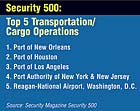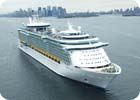Security 500 in Depth: the Biggest and Best


An article appeared in the online al Qaeda journal, Al-Ansar. Entitled “A Lesson in War,” its author wrote the following words: “Aborting the American economy is not an unattainable dream.” The statement, as vague as it is threatening, is a serious warning.
According to Jack Jarmon of Rutgers University, 80-90 percent of world trade is sea-born. Maritime trade, therefore, may be the single, most exposed link in the transportation system. Among world governments and global corporations the maritime trade transport system is a major source of concern. Particularly serious is the matter of container transport. The uniformity, velocity and anonymity of containerized traffic offer terrorists ample opportunity to inflict catastrophic damage to the commercial infrastructure.

CBP uses a pattern of programs to screen, select and inspect ocean-going cargo containers. As a primary tool of this strategy, CBP employs an Automated Targeting System (ATS) to automatically flag the highest risk shipments. ATS is a rules-based computer system, which sorts and screens each ship’s electronic records to determine cargo risk status. Because most importing companies are legitimate, CBP simply sorts shipments into one of two categories: trusted or untrusted.
Another tier in this layered approach to supply chain security is the Container Security Initiative (CSI) program. Under this program, the largest world ports host CSI teams of customs agents, which identify and inspect high-risk containers bound for the U.S. before they load onto vessels.
Complementing CSI is the Customs-Trade Partnership Against Terrorism, or C-TPAT Program. This is a joint government-business initiative. The aim of C-TPAT is to build a collaborative effort with the owners of the supply chain. Importers, carriers, brokers, warehouse operators and manufacturers are requested to conduct a security audit of their operations.
Yet, the material elements for the defense of the sea-born supply chain are in place. New regimes and regulatory frameworks, for the most part, need not be reinvented. The required technology, too, is available. Radio frequency identification, biometrics and computer security technologies are already benefiting from the demand for security goods and services. What seems to be missing is the sense of urgency and a willingness to reconsider previous notions about national security, contends Jarmon.
Links
Looking for a reprint of this article?
From high-res PDFs to custom plaques, order your copy today!




